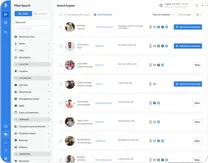
Have you ever wondered what the real difference is between inbound sales and outbound sales? Don’t worry, you’re not alone. Many businesses are asking this very question. Essentially it comes down to how each method starts the conversation with a potential customer.
💡 Inbound sales happen when a buyer reaches out to your business, outbound sales when your sales team makes the first move.
Quick overview – Inbound Sales vs Outbound Sales
- Inbound Sales: The customer comes to you. They fill out a form, download a resource or call for more information.
- Outbound Sales: Your sales reps reach out to them. This can be cold calling, cold emailing or using social media to connect with prospects.
Choosing the right sales strategy is a big deal for B2B lead generation. Now you know the basics, so you can decide which is best for your business. After all, the end goal is to generate leads that convert to customers.
What’s outbound?
Outbound sales is a proactive approach. Simply put, you and your team reach out to people and businesses that haven’t expressed interest in your product or service. Think of it as you going out into the world with a megaphone, trying to get the attention of those who might need what you offer. This can be cold calling, email marketing or even attending trade shows.
Now you might be thinking, why invest time and resources into outbound sales? Well it’s all about control. With outbound sales you have the ability to target specific decision makers and stakeholders within an organisation – those key people who can make or break a deal. It’s a way to get your message in front of the right eyes.
Another benefit of outbound sales is the ability to tailor your message to the needs and pain points of your prospects. Imagine crafting an email that speaks directly to the challenges a potential customer is facing. This direct approach can often get results faster than waiting for leads to come to you.
Of course outbound sales isn’t all sunshine and rainbows. It can be time consuming and at times, demoralising. Cold calling for example often comes with a high rate of rejection. But with persistence and a solid strategy the rewards can be worth it.
What’s inbound?
Inbound sales focus on attracting potential customers to your business organically. This often happens when a prospect finds your business through various inbound marketing strategies such as content marketing, social media, SEO and more. Essentially inbound leads are people who have shown interest in your product or service, so they’re warm leads.
Think about the last time you downloaded an ebook or attended a webinar. You probably signed up because you found the content valuable and relevant to your needs. That’s the core idea behind inbound sales – providing valuable content to attract and engage potential customers.
One of the big advantages of inbound sales is that the leads you get are generally more qualified. These prospects have already expressed some level of interest in what you offer, so conversion is more likely. However, inbound marketing requires a diverse set of skills including content creation, data tracking and SEO.
While inbound sales can be great for close relationships, it’s not always the best fit for high ticket items. In those cases potential customers often want a more direct approach where they can get personalized information and support. That’s where balancing inbound and outbound strategies becomes key to a solid B2B lead generation plan.
Outbound vs inbound: the differences explained
When it comes to B2B lead generation the choice between inbound and outbound sales strategies isn’t always black and white. Let’s break down the main differences to help you decide which one is right for your business.
Method: Inbound sales is all about attracting potential customers to your business by providing valuable content and experiences. Think blog posts, social media, SEO, webinars – these tools bring in prospects who are already interested in your industry or solution.
On the other hand outbound sales is about actively reaching out to potential customers who may not be aware of your product or service. This could be cold calling, email, direct mail. You’re initiating the conversation.
Focus and Goals: The main focus of inbound sales is to build trust and create a good customer experience. By providing valuable content businesses aim to nurture leads and guide them through the sales funnel organically. This is often cost effective and can generate high quality leads as the prospect has already shown some interest.
Outbound sales are more about getting leads quickly and reaching a large audience. While it’s more expensive and may result in lower quality leads, it allows businesses to be more aggressive and can get brand visibility and market penetration faster.
Results: The results of these methods depend on the specifics of your industry, target market and business goals. Inbound sales can lead to more sustainable growth by building long term relationships with customers. Outbound sales although seen as interruptive can be critical in industries where pipeline growth is immediate or decision makers are less likely to find your solution organically.
In the end finding the right balance between inbound and outbound will likely give you the best results. By leveraging the strengths of both approaches businesses can create a more robust and flexible lead generation strategy that suits their business.
Which is the better, outbound or inbound?
So which is the key to better sales – outbound or inbound? The honest answer is it depends on your business model, target market and resources. Both have their pros and cons and often a blended approach of both inbound and outbound sales tactics will be the best approach.
For example outbound sales require the right tools, mindset and discipline to add new leads to the top of your sales funnel. This proactive approach is good for businesses with longer sales cycles as you can build relationships over time. But it requires a lot of initial effort and consistency.
On the other hand inbound sales creates less friction as prospects reach out to you when they’re ready to buy, often after they’ve done their own research. This positions you as an industry leader thanks to your high quality content and thought leadership. But the downside is while inbound sales can generate high volume of leads, tracking data across multiple channels can be complex without a good CRM.
In the end the key to better sales is to know your customer. By understanding their preferences, needs and buying behavior you can tailor your sales strategy. Combining the strengths of both inbound and outbound will help you reach more and be more effective and lead to sustainable growth.
Swordfish.ai is one tool that can help both your inbound and outbound sales. By providing accurate contact details Swordfish.ai allows your sales team to reach out to new leads and also your inbound efforts are targeted to the right audience. That’s why Swordfish.ai is a game changer for better sales results.
Get a free trial 👉 https://swordfish.ai/


 View Products
View Products



